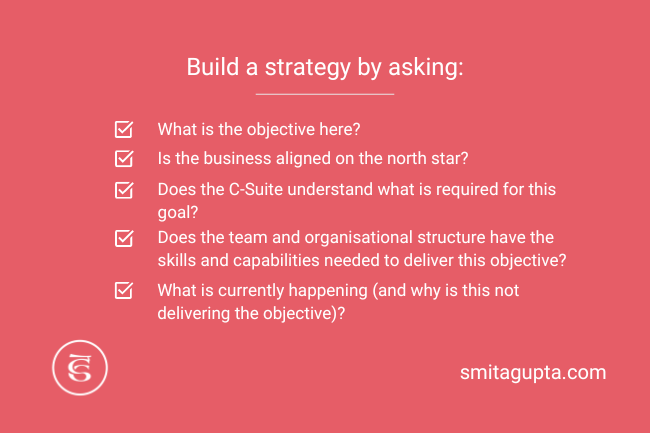As a marketing and growth advisor, one of the first things I start with is a go-to-market (GTM) strategy.
Gartner define a GTM strategy as:
“a plan that details how an organisation can engage with customers to convince them to buy their product or service and to gain a competitive advantage. A GTM strategy includes tactics related to pricing, sales and channels, the buying journey, new product or service launches, product rebranding or product introduction to a new market”
I would also add the importance of a GTM strategy building advocacy from your clients within the market, and the use of this in marketing to new clients.
When I build an organisation’s go-to-market strategy, I always start by asking these questions:

1️⃣ What is the objective here?
If you’re building a GTM strategy, you likely already know the importance of aligning product, sales and marketing to ensure a seamless, consistent experience for customers engaging with your product and brand.
Write in clear terms what the objective of the GTM strategy is and ensure this is understood across the business.
2️⃣ Is the business aligned on the north star? Is there clarity across the leadership team?
If you were to ask individuals from different teams what the business goals are, would they be able to answer? Would the leadership team have the same answers as well?
A GTM strategy should be aiming to position your product in a way that aligns with customers and contributes to the overall business objectives. Starting with a solid understanding of this north star across the team will help guide the strategy creation process.
3️⃣ Does the C-Suite understand what is required for the goals?
I have been involved in a lot of strategy meetings, and I often find the team have important and valuable ideas about the business but most are unlikely to happen. This may be restrictions on budget, time, talent or processes to enable further growth.
I ensure each goal is met with a reality check for the C-Suite team. As long as they are willing to delegate the right team and resources required for each goal, it will be achieved. If they’re not, there needs to be discussions about which sacrifices will be made or how additional support will be acquired to achieve the important goals.
4️⃣ Does the team and organisational structure have the skills and capabilities needed to deliver on the goals?
Aside from the will to support objectives, the C-Suite team needs to align the aspirations with reality. Does the team have the expertise to achieve the goals, or the resources to learn and deliver the objectives?
As part of the Smita Gupta Advisory business model, we offer clients access to our Talent Vault to bring on global experts to cover any shortfall between reality and the goals the business wants to achieve. Rather than simply providing the blueprint to reach your goals, we ensure our clients have every tool required, including the best talent.
5️⃣ What is currently happening (and what are the blockers)?
As part of understanding the current GTM gap, it is important to look at the current state of play.
- How is marketing reaching and engaging with your audience?
- What does public and private customer feedback tell you about the product?
- Does the whole company know the USPs that are most effective in sales?
- What is the current alignment between marketing, product and sales?
The business functions of marketing, product and sales are crucial to implementing a successful GTM strategy and auditing them helps to get your ducks in a row ahead of launching the next stage.
These five fairly simple questions give me a view of the present and the future. I then develop the roadmap to get from where we are to where we should be.
